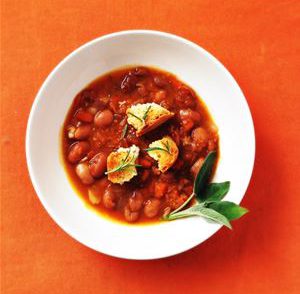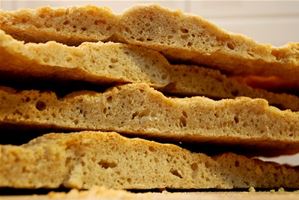Finally! A real Italian invitation to go olive picking-to experience picking olives in the countryside followed by a long Italian lunch. I called my host, Giacomo, only three times on my way to ask for more precise directions (and turned the car around twice without telling).
After arriving at Giacomo’s country house, I was taken straight to the olive orchards at the back of the house. There I met Francesca, who thrust what could only be described as a giant-size plastic comb into my palm. When I gave her a questioning look she said, ‘Ah, have you never done the raccolta before? No? OK, think of when we were kids and combed our doll’s hair; you grab the branch, pull down and comb. The olives fall out like knots and the leaves remain: it’s as though you have given your bambola a nice hairdo.’
It turned out to be fantastic fun, and hard physical work. My arms are still aching, happily.
The nets were down around the trees to catch and hold the olives that we had combed from the branches. Once finished, we carefully collected all the olives from the nets and poured them into the cestini (baskets). Before that could be done, however, each of the more mature trees needed a person to climb it and comb and cajole the olives from the higher hard-to-reach branches and into the net below. It was great fun: I haven’t climbed a tree in forever and it was heavenly.
We were called from the fields to stop the raccolta at around 2pm, with a rousing, ‘Basta, a tavola!’ Nine of us had managed to fill six cestini di olive, which were put in the shed where they would later be joined by other baskets filled by other family members. Once Giacomo’s family has finished the raccolta they will take all of their olives down to their local frantoio (olive press). Giacomo’s family fields have about 120 trees that produce approximately 75 to 80 kg of extra-virgin cold pressed oil every year for home consumption. Plenty, he says, since there are four of them in the family; and besides, his brother is already married. I am not sure how this relates to his lack of oil consumption, but it could simply be a classic ‘lost in translation’.
There was still time before lunch to make some amazing crostini con bietola e olio nuovo (chard and new olive oil) with some of Rosa’s freshly pressed oil. I followed Giacomo out to the vegetable patch, where he weighed me down with big, juicy, fresh green chard. I washed the freshly picked bietola leaves and tore out the tough white stalk. After ripping the leaves into large pieces by hand and tossing them into a pot with high sides, I covered them to let them steam for about five minutes. Once the leaves turned an emerald green, I turned off the heat and let them cool slightly. Fat wedges of Tuscan bread were toasted over the embers of olive branches while some of last year’s extra-virgin olive oil was heated in a pan, along with some finely chopped garlic and some chilli flakes. We added the cooked bietola and some smoked sea salt and sautéed before drizzling the bread with more oil, salt and extra juice from the bietola and finished with lashings of olio nuovo.
Lunch was a huge selection of salumi; formaggi; grilled meats cooked in a hearth with a grill placed over the top of the embers of olive branches; chubby little sausages made of cinta senese; pork ribs, cooked in an entire rib cage piece then cut; and juicy, marinated chicken thighs.
Good oil should be used for everything-even for cooking. The same rule applies to olive oil as it does to wine: don’t cook with anything you wouldn’t consider drinking. Now that the new oil is pressed, it is typical to use last year’s oil for cooking and to finish dishes with a filo d’olio nuovo, or as the nonne say for superstition, una croce d’olio.
RECIPE
Olive fritte (fried olives)
Using the sweeter and meatier more rounded black olive (which you can find now at the markets around Florence), wash the olives, then plunge them into a large pot of boiling water and drain immediately.
Heat up some good extra virgin olive oil in a pan with a couple of whole cloves of garlic and a chilli pepper. Cook the olives slowly in the oil until they have lost all of their water. Some of the skins will pop, this is fine. Drain, salt well and eat while still warm.
From The Tree to the Table
After picking the olives that are gathered either by hand or by mechanical means,
there is a five-step process to making extra-virgin olive oil and virgin olive oils.
Step 1 WASHING
Water jets on conveyor belts remove large particles of earth and foreign bodies, followed by the removal of olive leaves and small un-ripened fruit.
Step 2 FRANGITURA
The olives get pressed to produce a pulpy, usually violet-coloured substance, with no addition of heat or water. Though it is now done by mechanical means, it was traditionally done by grinding one stone around and around inside another larger stone, often pulled by a donkey or a horse, differing from region to region. I have friends my age from Sardinia who remember growing up with their olive oil being made like this.
Step 3 GRAMOLAZIONE
This is the important step of adding a recipe of movement, heat and time together to separate the pulp into diverse particles, therefore helping the microscopic oil drops unite into larger oil drops: normally 27°C for 15-20 minutes to get a high quality and low extraction. This year in Tuscany, for top-quality extra-virgin olive oils, it is good to get 15kg of finished product for every 100kg of olives picked.
Step 4 CENTRIFUGATION AND EXTRACTION
This machine separates the different particles produced by the gramolazione into: oil, vegetal water, and the remaining sansa or pomace, which is what the pulp is called.
Step 5 SEPARATION
This final step takes the oil, adds fresh pure water, mixes them together and filters the water away which in turn removes further impurities from the oil.
The oil is then taken and filtered through cotton, and bottled.
OLIVE OIL QUICK FACTS
Olio extravergine di oliva contains maximum 0.8% acidity and is considered the best in quality and flavour.
Olio extravergine di oliva has an acidity level of less than 2%. The flavour is considered ‘good’.
Pure olive oil or olive oil are blends of refined and virgin oil and lack the flavour intensity found in the virgin oils. Maximum 1.5% acidity.
Olive-pomace oil or olio di sansa di oliva is produced by extracting a further 3 – 6% of oil remaining in the paste after extraction through chemical means. It generally lacks flavour.
DOP is a guarantee that all phases of growth, production and transformation take place in one specific and defined area. For example, olio di oliva DOP Toscana must be produced and transformed in the specified DOP Toscana area following specific guidelines.







